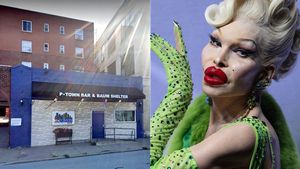
Ten years after the release of Birth, his controversial, ostensibly pedophilic reincarnation romance, writer-director Jonathan Glazer returns with Under the Skin, another uncompromising vision, very loosely adapted from Michael Faber's book of the same name. Starring Scarlett Johansson as "Laura," an extraterrestrial who touches down on Earth and assumes a sexy female form before lethally seducing men for her own race's benefit, the movie is an elliptical work of rare, painterly beauty, its story largely told via Glazer's gripping imagery. After analyzing a handful of the film's most memorable shots, we got some feedback from the director himself, who sat down at New York City's Bowery Hotel to dish on the significance of interlopers, mirrors, suspended nude men, and natural Scottish light.
1. Of Orbs and Oculi

Though it's somewhat perplexing at the start, the most impressive sequence of Under the Skin is ultimately its intro, a hallucinatory succession of circular images like the one above. Those who've cited this HAL-9000-like still to highlight Glazer's apparent Kubrickian influence aren't giving the director enough credit. Indeed, this robot-esque peeper resembles the "face" of the ominous supercomputer in 2001: A Space Odyssey, but what this sequence should be recalling for viewers is an earlier moment in 2001, when the shot of an ape-man's hurled bone cuts to a shot of a nuclear weapons satellite--an epic, multi-million-year leap encompassing humanity's progress in employing dangerous tools. It's the most famous match cut of all time, and Glazer, intentionally or not, reaches for its greatness while opening Under the Skin. Through this quick transition of orbs and oculi, he seamlessly gives us all the backstory we need, showing planets suggestive of the alien's origin, an otherworldly eye that's presumably the creature's own, and finally, the human iris belonging to the female form that's inhabited.
"I wanted the language of that sequence to feel like the alignment of planets, or the docking of a spaceship," Glazer says. "And then we take it, and turn it, and suddenly, that isn't a planet, that isn't a spaceship, that's an eyeball. And our character, this interloper, is going to be in the center of our eye--at the center of our being. And that's a scary place for an interloper to be."
2. Mirror Images

The use of mirrors and reflective surfaces as metaphorical cinematic tools is nothing groundbreaking, but there's something exceptional about the way Glazer incorporates them into Under the Skin, using them to convey both the vulnerability and ferocity of his antiheroine. Upon purchasing the tacky outfit that will essentially serve as her fuck-me garb (faux fur jacket, acid-washed jeans), Laura examines her red lipstick in a compact mirror, as shown in the above image, which might be the film's most popular still. Coupled with the curvature of a steering wheel, Laura's circular reflection is in keeping with the movie's orb motif, but it's hardly the only instance in which she finds her own form looking back at her. Entranced by the body she's taken (and, eventually, by humanity in general), the alien often stops to check herself out, and when she lures her Johns into a metaphysical, inky-black void, its glassy floor shows femme-fatale-times-two as she walks across it.
"I think the mirrors featured in the film are waiting for her to find her reflection," Glazer says. "The mirrors are kind of latent--waiting for her to notice them, and to notice herself."
3. Unmasked and Anonymous

One of Glazer's more interesting filmmaking approaches was embedding Johansson amid the citizens of the movie's Glasgow setting--without them knowing they were in the presence of an actress on a film shoot. To achieve this, the director not only had to bet on the fact that there'd be people in the world who wouldn't recognize the A-List bombshell, he had to commission the invention of a tiny, yet sophisticated, camera--one that could accompany Johansson undetected as she prowled the streets in a van, and still deliver imagery that was up to the standards of a highly particular auteur.
The result was the "One Cam," which captured shots like the one above, and left the passenger seat open for whatever horny passerby might want to get between Laura's supernatural thighs. This particular shot is bracingly effective, as it was filmed with the camera that helped maintain Johansson's anonymity, and it also renders anonymous the man outside her window--one of many would-be victims who might fall prey to the alien, and a native who's also likely being duped by a film crew. (When eventually filled in, willful participants later signed contracts to appear in the final cut.)
"We brought the film to the cast, we didn't bring the cast to the film," Glazer says. "It was all about being in the present tense. We built a camera because the camera we needed for those things just didn't exist. Photographically, I wanted everything to feel like it was witnessed. The camera was dispassionate."
4. Anti-Creation

Laura's method of ensnaring men soon becomes a rinse-and-repeat cycle: As she beckons them into that dark void of a hallway, she begins to strip, and they follow suit, shedding all clothes until they're standing nude with full erections. But while Laura continues to prance across her reflective floor, the men descend into it as if it's liquid, and are never seen again. That is, of course, until one man's experience below the surface is revealed, in a scene no viewer of the film will soon forget. Suspended in a sort of inverted amniotic fluid--its blue tint amps up the eeriness of its life-degrading qualities--the victim notices his joints and muscles failing him (with accompanying, goosebump-inducing creaks). Before long, he catches sight of Laura's last date, who's also floating in this womb of death, albeit in worse condition. As shown in the shot above, the new arrival reaches for the hand of his fellow prisoner, and it's surely no accident that the image evokes Michelangelo's The Creation of Adam, as Glazer is further upending the notion of birth in terribly stunning fashion. The two men touch fingers, and what happens next...well, let's just say the idea of shedding one's skin goes well beyond metaphor in this movie.
"I think the female sexuality in the film is something which is objectified," Glazer says. "The creature that Scarlett plays in the film exists to be objectified. And what she does in the course of the film, in her own discovery, is she reclaims that--she de-eroticizes her own image. And this void that is described by this black screen in this place where she takes these men--there's nothing there. Thematically...it's very involved. I can't really even distill it myself."
5. The Circle of (Unadorned) Life

For all of Under the Skin's formal panache, Glazer largely opted out of embellishing his visuals. Apart from some very notable, unmistakably stylized interludes, which give the movie an invaluably chic verve, the writer-director thought it imperative to use the natural resources at his disposal. This included photographing Glasgow's untouched setting in addition to employing its untried residents as actors. Thus, while he may have had to wait hours for the wind to aid the shot above, and for it to whip up just right to create yet another circular image, he did so with the intent of absorbing the atmosphere in all its reality. After all, such is precisely what Laura does the more she sticks around, going from predator to prey as she gets swept away in the whirlwind of humanity.
"With the aesthetic of this film, I was very much after something unadorned," Glazer says. "That was the key word in our vocabulary as we were putting this together. It had to feel unadorned, it had to be without affectation, it had to just be the world as it is--light had to be as it was. All that stuff comes from finding the right visual vocabulary of the story you're trying to tell."
Under the Skin opens in New York and L.A. April 4.































































